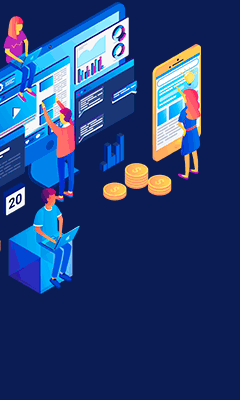Three Ways to Attract Tons of Traffic to Your Site
Three ways to Attract Tons of Traffic to Your Site:
Everyone wants more site traffic. But unless your site has a large advertising budget or your brand is established enough to get links from authorized sites, it probably feels like a small fish in an ocean full of whales and sharks. Do not give up! You can still find an advantage. It all depends on your creativity and willingness to be persistent, relevant and resourceful. There are two audiences that you must attract to search engines and human viewers. Here we show you how to win them and increase your traffic ... a lot!
1. SEO
Every few months, someone proclaims that SEO is dead. Again and again, the results prove otherwise. Search engine optimization has changed dramatically since its early days. However, the fact is that highly optimized sites work better than sites with the same value that are not optimized. Good SEO combines SEO on the page and off the page. Off-page SEO is primarily link building, but it goes much deeper. It is too big a problem for this article, so I will address it later. SEO on the page is all aspects of the site structure that make your page attractive to search engines. Although Google's guidelines change all the time, there are some excellent principles that will ensure that your site works well.
Avoid keyword cannibalization
Keyword cannibalization is one of the most overlooked and potentially catastrophic SEO problems. This is when the same term or phrase appears too many times on several pages of a site. Usually, it is done unintentionally. Multiple pages may have the same keyword goals in meta tags, titles, and content. This problem is typical of sites that get most of their traffic from some specific keywords. For example, locksmith sites get the most searches for the keywords Locksmith + City (for services). Typically, the word "Chicago locksmith" will have 20 times more searches than long-tail keywords such as "Chicago car locksmith," "Chicago residential locksmith," etc. Locksmith site designers might be tempted to point to the term "Chicago locksmith" on all service pages, as well as the home page. But that is a mistake: the search engine will not understand which page is the relevant homepage for that keyword. And so, none of your pages will end on the first page of Google. So how to avoid keyword cannibalism? Have each page of your website focus on a unique keyword. Meta tags, title tags and headers must be different on each page. Never optimize secondary pages using homepage keywords. If your site has many pages, make a list of pages and keywords to avoid overlapping.
Exhausting small things
A search engine algorithm verifies hundreds and thousands of page elements. Each element is a small factor in the ranking of your page. For your page to fall at the top, you must work systematically. No detail is small enough to overlook. Sites like Moz and Clickminded.com offer SEO checklists that cover dozens of items. Reviewing this list may seem arduous, but I suggest you do not neglect this process. It is difficult to know which element of the page has the power to improve your rating. Google changes the weight of different elements from time to time, so err on the safe site. Make your SEO site perfect. Solve the small details.
Perform site audits regularly
Site audit programs look for errors on your site, such as duplicate meta tags, broken links, lack of XML map and images without alt tags. The most important information comes from webmaster tools, as Google will alert you directly to site problems that affect your ranking. There are many programs that offer site auditing. Raven and Semrush are good to see.
The speed of the site
that Google now gives more and more important to the loading time of your page. There are two different metrics for this. The speed of the page is the time it takes for your page to fully display its content on a specific page or "time to the first byte". Site speed is the average speed of the sample pages on your site. The use of mobile devices increases all the time, so the speed of the site has become critical. Google offers a tool to test the speed of your site. It is very useful and shows how important the speed is for the ranking of your search engine. I find that fast sites rank better and become better than slower ones. The most important things to reduce site speed are: Enable compression: software like Gzip can compress your CSS, HTML and JAVASCRIPT files. For images, use Photoshop or similar image editing software. Minimize coding: either in CSS, JavaScript, and HTML, developers who write code manually create much cleaner code. The use of HTML editors adds a lot of unnecessary code. Minimize redirects: every time a redirect request occurs, a new HTTP request-response cycle is created. These take a long time. Improve server response time: check if your server can handle the number of visitors it has. Sometimes, updating your hosting plan can make a big difference in the speed and ranking of your site. The optimal response time of the server must be less than 200 ms. Use microdata: Microdata is an HTML WHATWG specification. Add metadata into existing content. Search engines process microdata from a web page and use it to provide a richer browsing experience for users. In other words, it allows the search engine to better understand your pages. This allows you to better display your page on the search results page and understand what is the most relevant context to display it. Check your microdata with this tool provided by Google.
2. Attract your visitor's attention
A first-time visitor to your site basically has one eye on your page and the other on the list of search results. If the content and design of your site do not immediately capture your attention, they move on to the next option. Google and other search engines give great relevance to the interaction of the visitor with your page. High bounce rates, the few visitors who return or the short time they spend on your page will affect your ranking. In addition, it is a sign that it has failed to capture the attention of its visitors and attract their interest. Here are some tips to make your pages more attractive at first glance. Headlines are the first textual element that your visitors notice. They have a great impact on the conversion and the bounce rate. Your title should be more than catchy: it should make the reader want to know more. The writers of Cosmopolitan and Vogue have this in science. Many vendors have analyzed how it works. You should definitely spend time with your main headlines and get an idea of yourself. Using effective images Visual data has a much stronger impact than text. Make sure your potential customer sees an image as soon as your page is loaded. The image should not be simply beautiful. We are exposed to so much visual information that a beautiful image does not cause a great impression. The image should generate interest in your page and make people want to read more. A good image for your page should: Turn attention to interest View the value proposition The most useful images are those that make the visitor understand what you will get from your site. A picture can really be worth 1000 words. Don't underestimate its power!
3. Be part of the social scene
To get to natural traffic, your site needs to create waves in social waters. It is not enough to publish brilliant content, you must master the art of the talk without having to meet face to face. Your content needs to make noise and needs you to be your public relations team. Getting involved in the community Simply posting on Facebook is not enough these days: you must stay active. Join group discussions, respond to comments and show that you care. Nothing is a greater blackout than using social networks only as a transmission channel. Answer questions and interact with your readers. Turn it into a real way to interact with your fans. Give real value and human warmth to people who show interest. Comment on other relevant blogs It may not bring you direct traffic, but smart and useful comments will establish your reputation and make people search for you and your site. Be relevant Don't just post the things that are most interesting to you. Watch your audience and give them what they want. Learn what they care about using surveys, reviewing your competition and reading the most popular questions asked in the forums. Content search tools such as Buzzsumo and Twitter Search can help you do it quickly and easily.
conclusion
Increasing site traffic is not a nightly process. It takes time, effort and care. You have to resort to searching engine algorithms and human beings alike. Therefore, your effort should combine search engine optimization, attention to site details, site aesthetics and commitment to the online community. Do it right and you'll be swimming in traffic.


























No comments